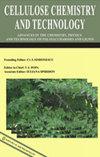RICE HUSK AS POTENTIAL RESOURCE FOR BIOMEDICAL APPLICATIONS: A REVIEW
IF 1.1
4区 农林科学
Q2 MATERIALS SCIENCE, PAPER & WOOD
Cellulose Chemistry and Technology
Pub Date : 2022-11-29
DOI:10.35812/cellulosechemtechnol.2022.56.81
引用次数: 0
Abstract
Rice husk (RH) is the by-product of the rice milling industry, and its primary disposal via burning can lead to detrimental environmental implications. While literature primarily focused on the potential of its silica component, the cellulosic constituent, which can be of applied value in the biomedical field, appears sparsely reported. Therefore, this review paper critically discusses both the silica and cellulose components of RH investigated for various biomedical uses (adsorbents, drug delivery systems, antioxidant and antitumor activities), and provides the elaborative overview of the chemical extraction methods for both components, while highlighting the needs for optimizing the extraction process for large scale industrial considerations. Discussions on several limitations of the current knowledge that mitigated readiness for biomedical applications (e.g. inadequate data from animal studies and clinical trials, as well as the lack of analytical confirmatory tests and non-standardized methods) are also presented. Considering the medicinal properties of RH, the possible utilization of its cellulose content as a new biomaterial for wound healing application is theorized. The information gathered here justifies the use of this agricultural biomass as a new source of economic wealth for biomedical industries, while minimizing the environmental threat that can be associated with its disposal.稻壳作为潜在生物医学资源的研究进展
稻壳(RH)是碾米工业的副产品,通过燃烧对其进行初步处理可能导致有害的环境影响。虽然文献主要关注其二氧化硅成分的潜力,但在生物医学领域具有应用价值的纤维素成分似乎很少被报道。因此,本文对RH的二氧化硅和纤维素成分进行了批判性的讨论,这些成分被研究用于各种生物医学用途(吸附剂、给药系统、抗氧化和抗肿瘤活性),并对这两种成分的化学提取方法进行了详细的概述,同时强调了出于大规模工业考虑而优化提取工艺的需要。还讨论了当前知识的几个局限性,这些局限性降低了生物医学应用的准备程度(例如,动物研究和临床试验的数据不足,以及缺乏分析验证测试和非标准化方法)。考虑到RH的药用特性,对其纤维素含量作为一种新型生物材料在创伤愈合中的应用进行了理论探讨。这里收集到的信息证明,利用这种农业生物质作为生物医学产业的新经济财富来源是合理的,同时最大限度地减少了与处置相关的环境威胁。
本文章由计算机程序翻译,如有差异,请以英文原文为准。
求助全文
约1分钟内获得全文
求助全文
来源期刊

Cellulose Chemistry and Technology
工程技术-材料科学:纸与木材
CiteScore
2.30
自引率
23.10%
发文量
81
审稿时长
7.3 months
期刊介绍:
Cellulose Chemistry and Technology covers the study and exploitation of the industrial applications of carbohydrate polymers in areas such as food, textiles, paper, wood, adhesives, pharmaceuticals, oil field applications and industrial chemistry.
Topics include:
• studies of structure and properties
• biological and industrial development
• analytical methods
• chemical and microbiological modifications
• interactions with other materials
 求助内容:
求助内容: 应助结果提醒方式:
应助结果提醒方式:


